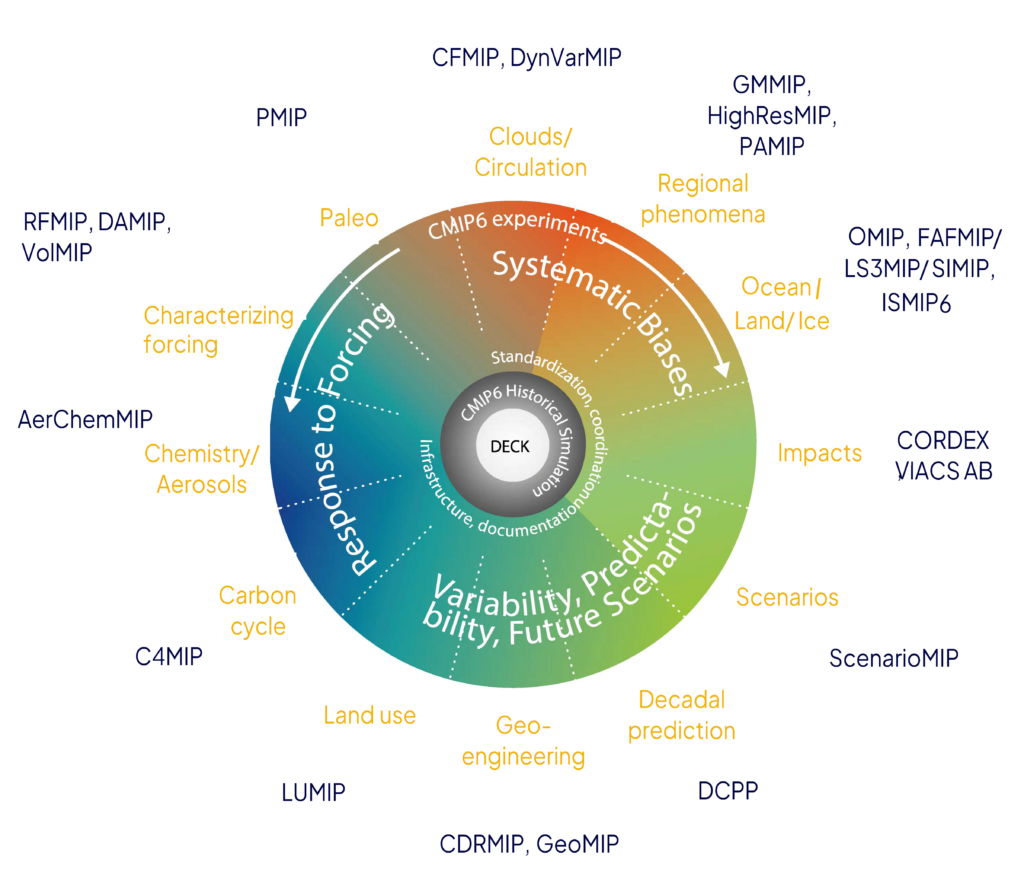Climate model intercomparisons and MIPs
If you know that future projections about climate change are based on climate modelling, the next obvious question to ask is 一 which climate model(s) are we talking about and trusting to portend our future? The answer lies in CMIP 一 or the Coupled Model Intercomparison Project 一 but before I introduce you to a lot of MIP-like acronyms, some background would be good.
Back in 1992, Lawrence Gates wrote about the AMIP 一 or the Atmospheric Model Intercomparison Project. This wasn't a particularly new thing for meteorology, but it was the first of its kind in the field of climatology. Why? Weather and climate models are essentially huge sets of code that take in some input, make a very large number of calculations, and return physically meaningful numbers for things like temperature, precipitation etc. Modelling is an expensive undertaking 一 both in terms of resources and skills. However, short-term weather forecasts tend to take fewer computational resources than long-term climate forecasts, leading to earlier and more intercomparisons regarding the former. Gates (1992) established a strategy for coordinated atmosphere-only climate model experiments for the time period 1979-1988, using the same set of input data across all participating climate models. This was the first formal Model Intercomparison Project (MIP), the first of many more to come. AMIP was also described as the first "electronic" model intercomparison, such that model outputs were made publicly available for others to use (a practice very welcome to all those who wish to study the climate but do not have adequate resources to run their own simulations).
AMIP led to CMIP. While AMIP had involved atmosphere-only climate models, CMIP involved coupled climate models 一 or models that simulate the climate by "coupling" different components of the Earth's climate such as the atmosphere, ocean, land etc. Naturally, coupled models are better representations of the climate than atmosphere-only models, but they are much more expensive to run. CMIP is currently in its 6th phase, and the CMIP6 model simulations formed the basis of the most recent IPCC Assessment Report (AR6). AMIP continues to run as part of CMIP.
Since I'm a paleoclimate modeller, allow me to take you through a small and otherwise unnecessary detour into PMIP 一 or the Paleoclimate Modelling Intercomparison Project. The latest phase of PMIP (PMIP4) included five experiments for five different time periods 一 Last Millennium (850-1849 CE), mid-Holocene (6,000 years ago), Last Glacial Maximum (21,000 years ago), Last Interglacial (127,000 years ago) and the mid-Pliocene Warm Period (3.2 million years ago). There are two "entry card experiments" 一 Last Glacial Maximum and mid-Holocene. All modelling centres/groups have to run one of the these two experiments as a minimum requirement for participation in PMIP4. These two entry cards have been long-standing favorites of the paleoclimate modelling community, and were the focus from the very first PMIP1 (which included only atmosphere-only climate models).
Circling back, the CMIP has its own entry cards, called "DECK" and "historical simulation". The full list of these experiments is:
- amip 一 we already talked about this, but now the time period to be simulated has been extended from 1979-1988 to 1979-2014.
- piControl 一 the pre-industrial period (1850 CE)
- abrupt-4x-CO2 一 in this experiment, CO2 is abruptly quadrupled and then kept constant
- 1pctCO2 一 in this experiment, CO2 is increased gradually at 1% per year
- historical 一 simulating the time period 1850 - 2014 CE.
Thus, every climate model that participates in CMIP has to run these experiments, in addition to any others (more below). Why? Experiments 1,2 and 5 have been designed for the evaluation of the participating climate models. Experiments 3 and 4 have been designed to address major research questions regarding climate sensitivity and feedbacks.
So what other experiments could be run as part of CMIP? Well, the list is quite large really. CMIP coordinates experiments for many research foci. The figure below mentions the research foci in orange, and the various different MIPs designed to address them in dark blue.
 |
| Source: https://wcrp-cmip.org/model-intercomparison-projects-mips/ |
In this deluge of MIPs, let's take a quick look at the one important MIP that is probably the most relevant to the public 一 ScenarioMIP (4 o' clock in the figure above). In O'Neill et al.'s words from the official paper:
"The Scenario Model Intercomparison Project (ScenarioMIP) is the primary activity within Phase 6 of the Coupled Model Intercomparison Project (CMIP6) that will provide multi-model climate projections based on alternative scenarios of future emissions and land use changes produced with integrated assessment models."Several things to note here:
(a) ScenarioMIP offers multi-model climate projections for the future which adds more credibility to whatever we know, compared to single-model projections
(b) the climate model projections themselves are based on future scenarios regarding emissions and land use changes
(c) future scenarios of emissions and land use changes are developed using something called integrated assessment models (IAMs) and IAMs are not the same as climate models.
I hope this helps readers understand a little more about how future climate change projections are made, and also helps them trust (and worry about) these projections more. It's a significant step forward that for the first time since the inception of AMIP and CMIP, an Indian model called IITM-ESM, developed at the Indian Institute of Tropical Meteorology (Pune), has participated in CMIP6. More about MIPs, especially PMIP, in future posts.
- - -
If you like such posts, you may subscribe here.
- - -
References (for experimental design, not results):
AMIP: Gates (1992) [Bulletin of the American Meteorological Society]
PMIP4: Kageyama et al. (2018) [Geoscientific Model Development]
CMIP6: Eyring et al. (2016) [Geoscientific Model Development]
ScenarioMIP: O'Neill et al. (2016) [Geoscientific Model Development]
Suggested reading:
How do climate models work? -- by Carbon Brief
CMIP6: the next generation of climate models explained -- also by Carbon Brief



Comments
Post a Comment